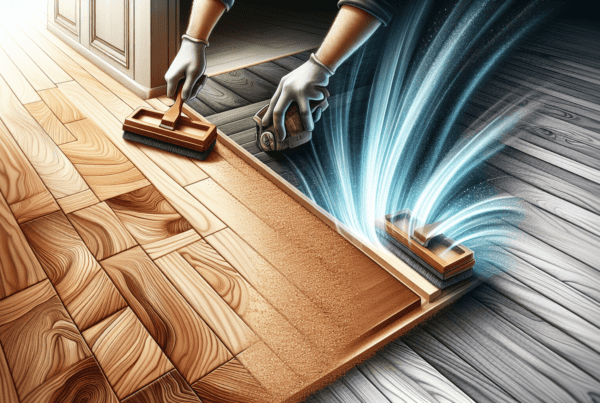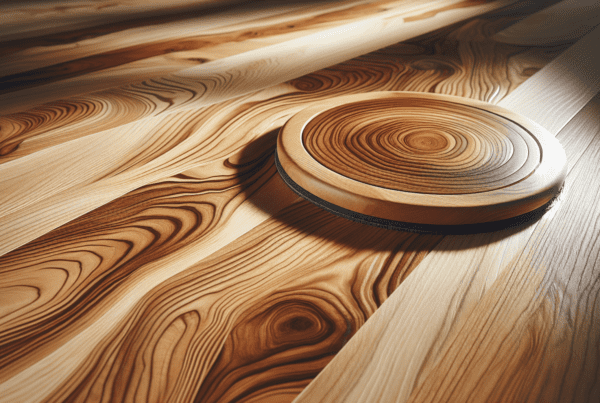In this article, we explore the eco-friendly approaches to timber floor sanding and finishing in Wellington, shining a light on how local experts are leading the way in sustainable practices. From using non-toxic materials to adopting energy-efficient methods, the focus is on ensuring that every step of the process not only brings out the natural beauty of the wood but does so in a way that minimizes environmental impact. Join us as we share insights into how these practices are transforming homes while protecting the planet.
Understanding Sustainable Timber
Definition of sustainable timber
Sustainable timber refers to wood that has been sourced from forests managed in a way that meets the needs of the present without compromising the ability of future generations to meet their own needs. This means that for every tree harvested, efforts are made to ensure that an equivalent tree grows back, preserving the natural balance of the forest ecosystem. Sustainable forestry practices also involve protecting water quality, biodiversity, and contributing to the overall health of the forest.
Benefits of using sustainable timber in flooring
Choosing sustainable timber for flooring has a plethora of benefits. Firstly, it helps in the conservation of forests, ensuring that they continue to thrive for generations to come. Secondly, sustainable timber tends to have a lower carbon footprint than non-sustainable options, as the forests act as carbon sinks, absorbing CO2 from the atmosphere. Additionally, using sustainable timber contributes to healthier indoor air quality, as it is less likely to have been treated with harmful chemicals.
Certification and standards for sustainable timber
There are several certifications and standards in place to assure consumers that the timber they are purchasing is truly sustainable. The Forest Stewardship Council (FSC) and Programme for the Endorsement of Forest Certification (PEFC) are two prominent international certifications. These certifications ensure that the timber meets strict environmental, social, and economic standards. Looking for these certifications when purchasing timber is a reliable way to ensure sustainability.
The Importance of Sustainable Practices in Timber Flooring
Environmental impact of floor sanding and finishing
Floor sanding and finishing have the potential to significantly impact the environment. Traditional sanding processes can release a substantial amount of dust and volatile organic compounds (VOCs) into the air, which can harm both indoor air quality and the wider environment. Moreover, some finishes and sealants contain toxic substances that further exacerbate this issue.
Long-term benefits for homeowners
Investing in sustainable timber flooring and eco-friendly sanding and finishing techniques brings several long-term benefits for homeowners. These floors are often more durable and require less maintenance over time. Additionally, sustainable floors can improve indoor air quality and even increase the value of a home, as more buyers are looking for eco-friendly features.
Contribution to the local economy in Wellington
Choosing sustainable timber flooring and local services in Wellington not only benefits the environment but also contributes significantly to the local economy. Supporting local businesses helps keep money within the community, creating jobs and fostering economic growth. Moreover, local providers are likely to have a better understanding of the specific needs and challenges related to the Wellington climate and environment.
Selecting Sustainable Timber for Floor Sanding & Finishing
Types of sustainable timber available in Wellington
Wellington offers a variety of sustainable timber options suitable for floor sanding and finishing. Native species such as Rimu and Kauri can be sourced sustainably, as well as introduced species like Douglas Fir and Oak. These options provide homeowners with a range of aesthetics and physical properties to choose from.
Factors to consider when choosing sustainable timber
When selecting sustainable timber, several factors need to be considered. The durability of the wood, especially in relation to the expected foot traffic, is crucial. Additionally, the timber’s compatibility with eco-friendly finishes and its overall environmental impact should be evaluated. The appearance of the wood and how it complements the home’s interior design is also an important consideration.
Local sources of sustainable timber
Finding local sources of sustainable timber in Wellington can be facilitated by reaching out to certified suppliers who specialize in eco-friendly products. Local sawmills and timber merchants who carry FSC or PEFC certified wood are good starting points. Engaging with community wood recycling programs can also uncover unique and sustainable timber options.
Preparation for Floor Sanding
Assessing the current state of timber floors
Before beginning any sanding project, it’s essential to assess the current state of the timber floors. This involves checking for any signs of damage, wear, or structural issues that may need to be addressed beforehand. Identifying any previous finishes or treatments is also crucial, as this can affect the choice of sanding and finishing techniques.
Pre-sanding preparations
Proper preparation is key to a successful and sustainable floor sanding project. This includes removing all furniture and fixtures from the area, ensuring adequate ventilation, and repairing any damage to the floorboards. Sealing off the work area to prevent dust from spreading throughout the home is also an important step.
Minimizing dust and environmental impact during sanding
To minimize the environmental impact during sanding, it’s important to use dust extraction systems and low-dust sanding equipment. This not only reduces the amount of airborne dust but also decreases the clean-up time and improves air quality. Opting for sanding equipment that has been specifically designed to be eco-friendlier can significantly lessen the environmental footprint of the project.
Sustainable Sanding Techniques
Eco-friendly sanding equipment
Eco-friendly sanding equipment is designed to minimize dust and reduce the energy consumption of the sanding process. These machines often come with advanced dust extraction features and operate more efficiently, which not only contributes to a cleaner working environment but also helps in conserving electricity.
Dust reduction methods
In addition to using eco-friendly sanding equipment, employing dust reduction methods is crucial. Using vacuum systems attached to the sanding equipment can capture dust at the source. Furthermore, prepping the area by sealing off air vents and doorways can prevent the spread of dust to other parts of the home.
Use of non-toxic finishes and sealants
Once the sanding is complete, choosing non-toxic finishes and sealants is vital for maintaining indoor air quality and reducing environmental impact. There are a variety of eco-friendly products on the market, including water-based finishes, natural oil sealants, and wax-based options. These products not only protect the floor but also ensure a safer environment for homeowners and pets.
Choosing Eco-Friendly Finishes
Types of sustainable finishes
Sustainable finishes for timber flooring come in several forms. Water-based polyurethanes are popular due to their low VOC content and quick drying times. Natural oil finishes, made from plant-based oils and waxes, offer a more natural look and easy maintenance. Hardwax oils, another eco-friendly option, provide a durable, repairable surface that enhances the wood’s natural beauty.
Benefits of eco-friendly finishes
Eco-friendly finishes offer numerous benefits beyond their reduced environmental impact. They are generally safer for both applicators and inhabitants, emitting lower levels of harmful VOCs. Additionally, these finishes often result in floors that are easier to maintain and repair, extending the lifespan of the flooring and reducing the need for frequent refinishing.
Application techniques for sustainable finishes
Applying sustainable finishes requires attention to detail and adherence to specific techniques. Preparing the surface properly by ensuring it is clean, dry, and free of dust is essential. The application method, whether by brush, roller, or pad, will vary depending on the type of finish. Following the manufacturer’s recommendations for drying times and the number of coats is crucial for achieving the best results.
Maintenance of Sustainably Finished Timber Floors
Daily care practices
Maintaining sustainably finished timber floors involves simple but effective daily care practices. Regular sweeping or vacuuming can prevent grit and dirt from scratching the surface. Promptly cleaning up spills and avoiding the use of harsh chemicals are also key to preserving the floor’s finish and overall health.
Long-term maintenance strategies
For long-term maintenance, periodically refreshing the finish can be beneficial, especially in high-traffic areas. This might involve a light sanding and reapplication of the finish to restore the floor’s protective layer. Utilizing rugs and mats at entrances can also help in reducing wear.
Repairing sustainably finished floors
When repairs are needed, sustainably finished floors often offer easier and more environmentally friendly options. Many finishes can be spot-repaired without the need to refinish the entire floor area. This not only saves time and resources but also extends the life of the flooring.
Advantages of Choosing Local Wellington Services
Supporting local businesses
Choosing local Wellington services for sustainable timber floor sanding and finishing has the dual benefit of supporting local businesses and ensuring a high-quality service. Local providers are invested in the community and are likely to offer personalized, attentive service.
Understanding local climate considerations in floor care
Wellington’s unique climate can pose specific challenges for timber flooring, such as humidity and temperature fluctuations. Local flooring experts are familiar with these conditions and can offer tailored advice on the best sustainable materials and finishes to use, ensuring long-lasting, beautiful floors.
Custom solutions for Wellington homes
Local services can provide custom solutions that cater specifically to the needs of Wellington homes. Whether it’s sourcing local sustainable timber, understanding the architectural style of the area, or providing maintenance advice suited to the local climate, Wellington’s floor sanding and finishing professionals can deliver bespoke solutions that national or international companies may not offer.
Case Studies: Successful Sustainable Floor Projects in Wellington
Overview of selected projects
We’ve been part of several successful sustainable floor sanding and finishing projects across Wellington. These have ranged from historic home restorations to modern new builds, each with a focus on sustainability.
Challenges and solutions
One common challenge is balancing the aesthetic desires of homeowners with the need for sustainable practices. Solutions have included sourcing reclaimed timber for projects or using innovative, eco-friendly finishes that do not compromise on quality or durability.
Feedback from homeowners and professionals
The feedback from these projects has been overwhelmingly positive. Homeowners appreciate the beauty and durability of their sustainable floors, and professionals in the industry have noted the seamless integration of sustainable practices into their projects, proving that sustainability and quality can go hand in hand.
How to Get Started with Your Sustainable Floor Sanding & Finishing Project
Planning your project timeline
Starting with a clear timeline in mind is crucial for a successful project. Consider the scope of the work, from the initial assessment and preparation to the sanding, finishing, and drying times. Allowing for some flexibility in the timeline for unforeseen issues or decisions is also wise.
Selecting the right professionals in Wellington
Choosing the right professionals for your project is essential. Look for those with experience in sustainable flooring projects and who are committed to using eco-friendly materials and practices. Checking for certifications, reviews, and references can help in making an informed decision.
Budget considerations for sustainable options
While sustainable options may initially seem more expensive, it’s important to consider the long-term savings and benefits. Durable, low-maintenance materials can reduce future costs, and choosing local services can often offer more competitive pricing. Setting a realistic budget that accounts for the quality and sustainability of the materials and services will ensure a satisfying and environmentally responsible project outcome.
By taking these steps and considerations to heart, we can make a tangible difference in the sustainability of our homes and our planet, starting with our very floors.







